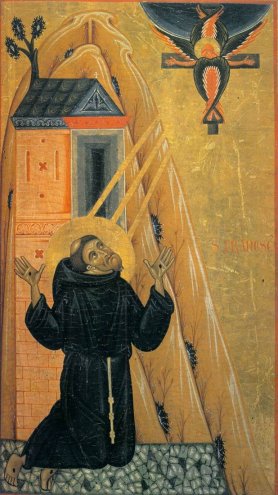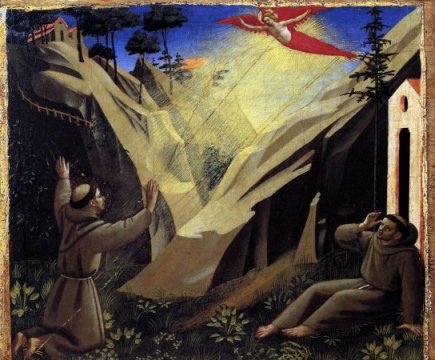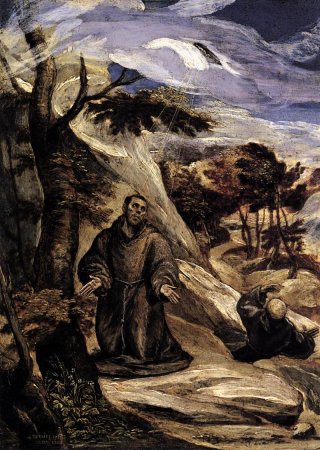
Here's how Bonaventutre describes what happens.
On a certain morning about the Feast of the Exaltation of Holy Cross, while he was praying on the side of the mountain, he beheld a Seraph having six wings, flaming and resplendent, coming down from the heights of heaven. When in his flight most swift he had reached the space of air nigh the man of God, there appeared betwixt the wings the Figure of a Man crucified, having his hands and feet stretched forth in the shape of a Cross, and fastened unto a Cross. Two wings were raised above His head, twain were spread forth to fly, while twain hid His whole body. Beholding this, Francis was mightily astonished, and joy, mingled with sorrow, filled his heart. He rejoiced at the gracious aspect wherewith he saw Christ, under the guise of the Seraph, regard him, but His crucifixion pierced his soul with a sword of pitying grief. He marvelled exceedingly at the appearance of a vision so unfathomable, knowing that the infirmity of the Passion doth in no wise accord with the immortality of a Seraphic spirit. At length he understood therefrom, the Lord revealing it unto him, that this vision had been thus presented unto his gaze by the divine providence, that the friend of Christ might have foreknowledge that he was to be wholly transformed into the likeness of Christ Crucified, not by martyrdom of body, but by enkindling of heart. Accordingly, as the vision disappeared, it left in his heart a wondrous glow, but on his flesh also it imprinted a no less wondrous likeness of its tokens. For forthwith there began to appear in his hands and feet the marks of the nails, even as he had just beheld them in that Figure of the Crucified. For his hands and feet seemed to be pierced through the midst with nails, the heads of the nails shewing in the palms of the hands, and upper side of the feet, and their points shewing on the other side; the heads of the nails were round and black in the hands and feet, while the points were long, bent, and as it were turned back, being formed, of the flesh itself, and protruding therefrom. The right side, moreover, was—as if it had been pierced by a lance—seamed with a ruddy scar, wherefrom ofttimes welled the sacred blood, staining his habit and breeches.
What is particularly interesting is the choice of angel, confirmed in a number of accounts. Seraphs were at the top of the angelic hierarchy, and did not concern themselves with earthly matters. 'Christ under the guise of a seraph' and, of course, the stigmata, reinforce the idea of Francis as the second Christ, Franciscus alter Christus.


Above: a very early image, c1240, in Byzantine style. Master of San Francesco Bardi, Uffizi, Florence. It was painted just 16 years after the supposed date of the event itself. On the left: the fresco from the Upper Church, San Francesco, Assisi.


Above left: Fra Angelico, Pinacoteca Vatican. Above right: Domenico Ghirlandaio, Fresco, Santa Trinita, Florence.


On to the death of St Francis
Back to page 1 Home page - explore the site